Uptown Coffee Company to open second location at NewBo City Market
CBJ News Staff

A medical professional examines a young patient at the Eastern Iowa Health Center. CREDIT EIHC
The Eastern Iowa Health Center’s (EIHC) plans for a new, largely automated pharmacy in the heart of its service area will not only help expand the organization’s stated mission — “exceptional health care for all” — but will address the pharmaceutical crisis in southeast Cedar Rapids, created with the closing of the First Avenue Hy-Vee earlier this year.
And not only will the new pharmacy be a…

Get immediate, unlimited access to all subscriber content and much more.
Learn more in our subscriber FAQ.
Do you want to read and share this article without a paywall?
